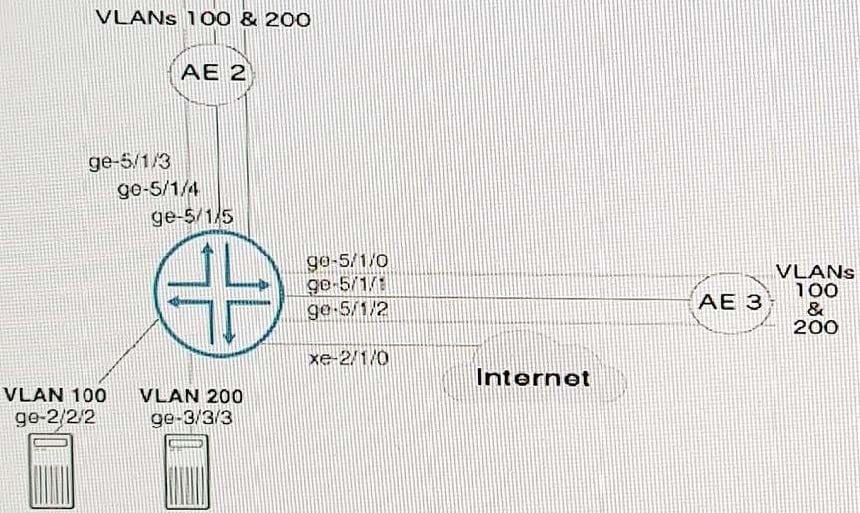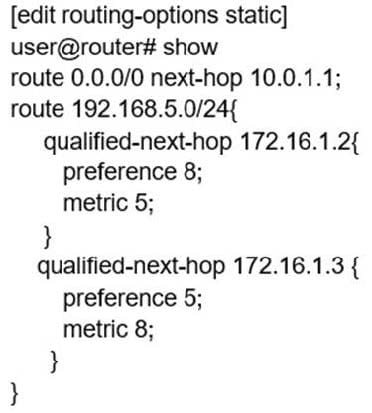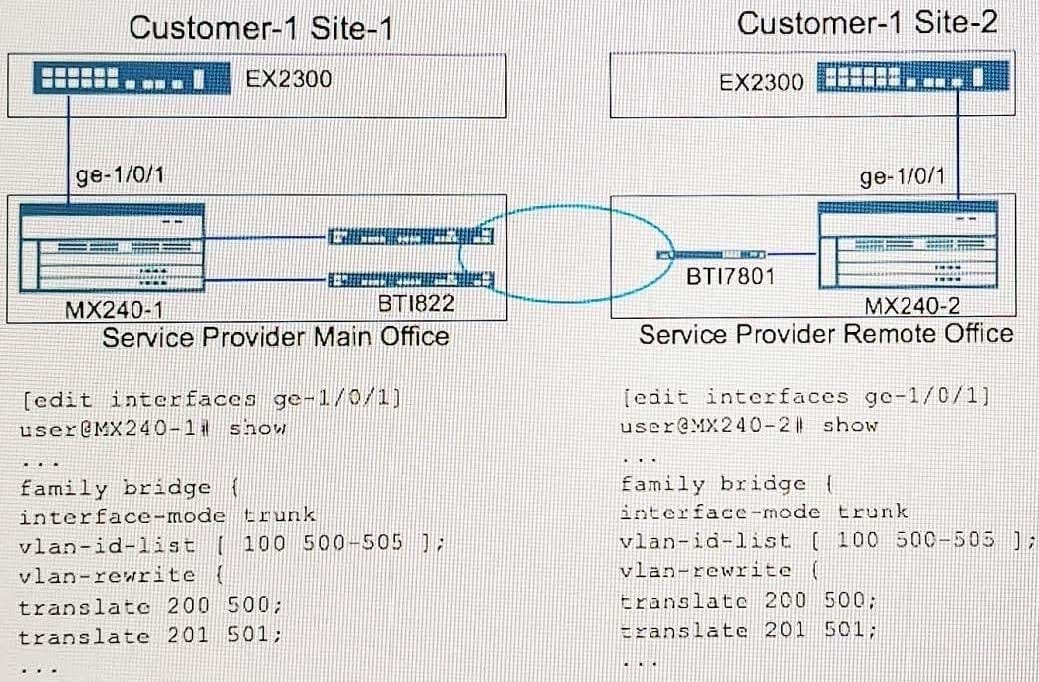Exam Details
Exam Code
:JN0-361Exam Name
:Service Provider Routing and Switching, Specialist (JNCIS-SP)Certification
:Juniper CertificationsVendor
:JuniperTotal Questions
:542 Q&AsLast Updated
:Mar 30, 2025
Juniper Juniper Certifications JN0-361 Questions & Answers
-
Question 31:
Which statement is true regarding default MPLS label handling?
A. A router that pops a label from a label stack always pushes a new label on the packet
B. A router that pops a label from a label stack forwards a frame based on the label that was popped.
C. A router that pops a label from a label stack forwards a frame based on the underlying destination IP address.
D. A router that pops a label from a label stack applies class of service based on the IP header to ToS bits.
-
Question 32:
Which two statements are true about VRRP? (Choose two.)
A. VRRP requires redundant REs on each member.
B. Interfaces within the same VRRP group do not have to be on the same subnet for each member.
C. Interfaces within the same VRRP group must be on the same subnet for each member.
D. VRRP does not require redundant REs on each member.
-
Question 33:
Which two statements correctly describe the BGP community attribute? (Choose two.)
A. Only one community can be associated with a route.
B. The community attribute is an optional nontransitive attribute.
C. Multiple communities can be associated with a route.
D. The community attributes is an optional transitive attribute.
-
Question 34:
Click the Exhibit.

On an MX Series device, you must enable routing between VLANs 100,200, and the Internet ge-5/1/0, and ge-5/1/2 are bundled into interface ae3. Ge-5/1/4, and ge-5/1/5 are bundles into interface ae2. Both AE bundles trunk VLANs 100 and 200. In this scenario, what is the correct configuration snippet for VLAN 100?
A. interfaces {xe-2/1/0 {unit 0{family inter {address 10.0.10.2/24;}}}irb {unit 0{family inet {address 10.0.1.2/24;}}unit 1 family inet {address 10.0.2.2/24;}}}}bridge-domains {vlan-100{domain-type bridge;vlan-id 100; interface ge-2/2/2.100; interface ae1.100; interface ae3.100; routing-interface irb.0;}}
B. interfaces {xe-2/1/0{unit 0{family inet {address 10.0.10.2/24;}}}ip-0/0/0{unit 0{family inet {address 10.0.1.2/24;}}unit 1{family inet {address 10.0.2.2/24;}}}}bridge-domains {vlan- 100{domaintype bridge;vlan-id 100; interface ge-2/2/2.100; interface ae1.100; interface ae3.100; interface ip-0/0/0.0;}}
C. interfaces {xe-2/1/0 {unit 0 {family inet {address 10.0.10.2/24;}}}irb {unit 0{family inet {address 10.0.1.2/24:}}unit 1 {family inet {address 10.0.2.2/24;}}}}bridge- domains {vlan-100{domain-type bridge;vlan-id 100; interface ge-2/2/2.100; interface ae1.100; interface ae3.100;}}
D. interfaces {xe-2/1/0 {unit 0{family inet {address 10.0.10.2/24;}}}ip-0/0/0 {unit 0 {family inet {address 10.0.1.2/24;}}unit 1 {family inet {address 10.0.2.2/24;}}}}bridge-domains {vlan-100{domain-type bridge;vlan-id 100; interface ge-2/2/2.100; interface xe-2/1/0.0; Interface ae1.100; interface ae3.100; interface ip-0/0/0.0;}}
-
Question 35:
What is the TTL value for EBGP?
A. 64
B. 48
C. 255
D. 1
-
Question 36:
Which statement is true when using VLANs in a bridge domain on an MX Series device?
A. The VLAN tags of the received packet are always translated.
B. Only outer VLAN tags can be normalized.
C. The VLAN tag of the received packet must match the VLAN tags associated with one of the logical interfaces.
D. Outer and inner VLAN tags always checked at egress.
-
Question 37:
What are two methods for decreasing the size of an OSPF link-state database (LSDB)? (Choose two.)
A. Ensure that all routers on a shared segment are configured with a priority value of 0.
B. Use an interface type of p2p when possible.
C. Segment large groups of routers into areas.
D. Change a stub area to NSSA when possible.
-
Question 38:
Click the Exhibit.

Referring to the configuration shown in the exhibit, which statement is true?
A. Traffic destined to address 192.168.5.1 will take next-hop 172.16.1.2.
B. Traffic destined to address 192.168.5.1 will alternate between next-hops 172.16.1.2 and 172.16.1.3
C. Traffic destined to address 192.168.5.1 will take next-hop 10.0.1.1.
D. Traffic destined to address 192.168.5.1 will take next-hop 172.16.1.3.
-
Question 39:
Click the exhibit.

A customer has two VLANs to extend between Site-1 and Site-2. The customer does not want to route the VLANs or renumber the VLANs.
Referring to the exhibit, which two VLAN IDs are egressing the MX Series device towards the optical transport network after translation? (Choose two.)
A. 500
B. 501
C. 201
D. 200
-
Question 40:
Which three statements are true about GRES? (Choose three.)
A. Kernel information is preserved.
B. Interface information is preserved.
C. GRES requires only one RE.
D. GRES requires redundant REs.
E. Control plane information is preserved.
Related Exams:
JN0-102
Internet Associate, Junos(JNCIA-Junos)JN0-104
Junos, Associate (JNCIA-Junos)JN0-105
Junos, Associate (JNCIA-Junos)JN0-1101
Juniper Networks Certified Design Associate (JNCDA)JN0-130
Juniper networks Certified internet specialist.e(jncis-e)JN0-1301
Data Center Design, Specialist (JNCDS-DC)JN0-1302
Data Center Design Specialist (JNCDS-DC)JN0-1331
Security Design, Specialist (JNCDS-SEC)JN0-1332
Security Design, Specialist (JNCDS-SEC)JN0-1361
Service Provider Design Specialist (JNCDS-SP)
Tips on How to Prepare for the Exams
Nowadays, the certification exams become more and more important and required by more and more enterprises when applying for a job. But how to prepare for the exam effectively? How to prepare for the exam in a short time with less efforts? How to get a ideal result and how to find the most reliable resources? Here on Vcedump.com, you will find all the answers. Vcedump.com provide not only Juniper exam questions, answers and explanations but also complete assistance on your exam preparation and certification application. If you are confused on your JN0-361 exam preparations and Juniper certification application, do not hesitate to visit our Vcedump.com to find your solutions here.